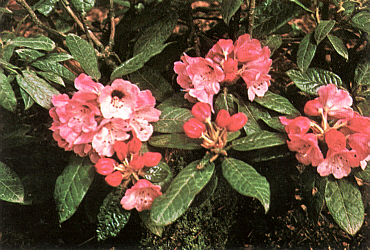QBARS - v26n2 Rock 57, Series Barbatum, S.s. Crinigerum
Rock 57 Series Barbatum, S.s. Crinigerum
Cecil Smith, Aurora, Oregon

|
|
Series Barbatum, s.s. crinigerum Rock 57
Photo by Cecil Smith |
Several people with a broad knowledge of the species of rhododendrons, and particularly of the 1948 Rock numbers, say that in some numbers there is considerable variation. It is also said that some clones do not conform to the description of any species. The one pictured must be one of them, as I have been unable to get anyone to commit himself, other than to say that it has to be in the Crinigerum subseries, which is composed of crinigerum and bainbridgeanum .
The original plant died, but there are cuttings and seedlings. The seedlings at two years of age still have immature leaves and they appear to be quite uniform, and similar to the parent plant. I have not seen any other plants of number 57.
The outline of the leaves, as shown in the picture, fits more closely the description of bainbridgeanum than of crinigerum . However, the underside of the leaf has a thick, rich yellow indumentum like that of the best of the crinigerums , rather than the thin covering as described in the species book. A plant labeled bainbridgeanum which I saw in the Stevenson collection at the Valley Garden in Windsor Great Park, had the light indumentum as described. A picture taken also shows but six flowers in the truss, which conforms with the description in the species book. The plant of Rock 57 was about three feet high and five feet wide at twenty-three years, a growth habit conforming to that described for bainbridgeanum . It was smaller than other Rock numbers in our garden fitting the description of crinigerum . The branches are much less hairy than those of crinigerum , and have much less accumulation of discarded growth.
The number of flowers in a truss approaches the number ascribed to crinigerum but not nearly so many as seen on other Rock numbers of the same species. The color in the picture is quite true.

|
|
FIG. 29.
R. barbatum
. This highly acclaimed species exhibits
its blood-red flowers during February in the North- west. Eventually forming a small tree, R. barbatum is notable for its plum-red bark easily observed through its sparsely foliaged branches (Editor). Cecil Smith photo |
